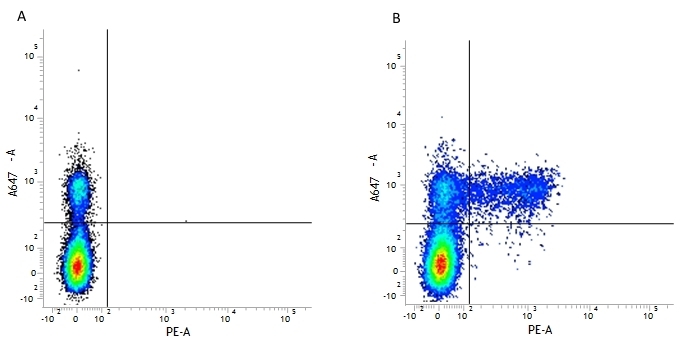KIR antibody | NKVFS1


Mouse anti Human KIR:RPE
- Product Type
- Monoclonal Antibody
- Clone
- NKVFS1
- Isotype
- IgG1
- Specificity
- KIR
| Mouse anti Human KIR antibody, clone NKVFS1 recognizes KIR2D members of the killer cell immunoglobulin (Ig)-like receptor (KIR) family, CD158a, CD158b and P50.3. KIR2D family members are cell surface glycoproteins with two Ig domains, which are expressed on natural killer cells and some T cells. Mouse anti Human KIR antibody, clone NKVFS1 recognizes the long and short forms CD158a and CD158b (KIR2DL, KIR2DS1 and KIR2DS2 respectively) and also p50.3 (KIR2DS4). Mouse anti Human KIR antibody, clone NKVFS1 is reported to have functional activity, activating NK cell cytotoxicity via KIR2DS and inhibiting via KIR2DL forms.. |
- Target Species
- Human
- Product Form
- Purified IgG conjugated to R. Phycoerythrin (RPE) - lyophilized
- Reconstitution
- Reconstitute with 1 ml distilled water
- Preparation
- Purified IgG prepared by affinity chromatography on Protein G from tissue culture supernatant
- Buffer Solution
- Phosphate buffered saline
- Preservative Stabilisers
- 0.09% sodium azide (NaN3)
1% bovine serum albumin
5% sucrose - Max Ex/Em
-
Fluorophore Excitation Max (nm) Emission Max (nm) RPE 488nm laser 496 578 - Regulatory
- For research purposes only
- Guarantee
- 12 months from date of despatch
DO NOT FREEZE.
This product should be stored undiluted. This product is photosensitive and should be protected from light. Should this product contain a precipitate we recommend microcentrifugation before use.
| Application Name | Verified | Min Dilution | Max Dilution |
|---|---|---|---|
| Flow Cytometry | Neat |
- Flow Cytometry
- Use 10μl of the suggested working dilution to label 106 cells in 100μl
How to Use the Spectraviewer
Watch the Tool Tutorial Video ▸- Start by selecting the application you are interested in, with the option to select an instrument from the drop down menu or create a customized instrument
- Select the fluorophores or fluorescent proteins you want to include in your panel to check compatibility
- Select the lasers and filters you wish to include
- Select combined or multi-laser view to visualize the spectra
| Description | Product Code | Applications | Pack Size | List Price | Your Price | Quantity | |
|---|---|---|---|---|---|---|---|
| Mouse IgG1 Negative Control:RPE | MCA928PE | F | 100 Tests | Log in | |||
| List Price | Your Price | ||||||
| Log in | |||||||
| Description | Mouse IgG1 Negative Control:RPE | ||||||
| Description | Product Code | Applications | Pack Size | List Price | Your Price | Quantity | |
|---|---|---|---|---|---|---|---|
| Human Seroblock | BUF070A | F | 50 Test | Log in | |||
| List Price | Your Price | ||||||
| Log in | |||||||
| Description | Human Seroblock | ||||||
| Human Seroblock | BUF070B | F | 200 Test | Log in | |||
| List Price | Your Price | ||||||
| Log in | |||||||
| Description | Human Seroblock | ||||||
References for KIR antibody
-
Spaggiari, G.M. et al. (2002) Soluble HLA class I molecules induce natural killer cell apoptosis through the engagement of CD8: evidence for a negative regulation exerted by members of the inhibitory receptor superfamily.
Blood. 99 (5): 1706-14. -
Spaggiari, G.M. et al. (2002) Soluble HLA class I induces NK cell apoptosis upon the engagement of killer-activating HLA class I receptors through FasL-Fas interaction.
Blood. 100 (12): 4098-107. -
Patterson, S. et al. (2008) Human invariant NKT cells display alloreactivity instructed by invariant TCR-CD1d interaction and killer Ig receptors.
J Immunol. 181 (5): 3268-76. -
Moesta, A.K. et al. (2009) Chimpanzees use more varied receptors and ligands than humans for inhibitory killer cell Ig-like receptor recognition of the MHC-C1 and MHC-C2 epitopes.
J Immunol. 182 (6): 3628-37. -
Wang, Y. et al. (2009) Characteristics of expanded CD4+CD28null T cells in patients with chronic hepatitis B.
Immunol Invest. 38 (5): 434-46. -
Older Aguilar, A.M. et al. (2010) Coevolution of killer cell Ig-like receptors with HLA-C to become the major variable regulators of human NK cells.
J Immunol. 185 (7): 4238-51. -
Hilton, H.G. et al. (2015) The production of KIR-Fc fusion proteins and their use in a multiplex HLA class I binding assay.
J Immunol Methods. 425: 79-87. -
Van Der Ploeg, K. et al. (2017) Modulation of Human Leukocyte Antigen-C by Human Cytomegalovirus Stimulates KIR2DS1 Recognition by Natural Killer Cells.
Front Immunol. 8: 298.
View The Latest Product References
-
Wijaya, R.S. et al. (2020) Expansion of dysfunctional CD56-CD16+ NK cells in chronic hepatitis B patients.
Liver Int. Dec 23 [Epub ahead of print].
- Synonyms
- Killer Cell IMMUNOGLOBIN-LIKE Receptors
- RRID
- AB_324524
- UniProt
- P43626
- P43627
- P43628
- Q14954
- P43631
- P43632
- Entrez Gene
- KIR2DL1
- KIR2DL2
- KIR2DL3
- KIR2DS2
- KIR2DS4
- KIR2DS1
- GO Terms
- GO:0005515 protein binding
- GO:0002769 natural killer cell inhibitory signaling pathway
- GO:0004872 receptor activity
- GO:0005887 integral to plasma membrane
- GO:0006955 immune response
- GO:0005886 plasma membrane
- GO:0016021 integral to membrane
- GO:0050776 regulation of immune response
- GO:0003823 antigen binding
- View More GO Terms
- GO:0004888 transmembrane receptor activity
MCA2243PE
If you cannot find the batch/lot you are looking for please contact our technical support team for assistance.
Please Note: All Products are "FOR RESEARCH PURPOSES ONLY"
View all Anti-Human ProductsAlways be the first to know.
When we launch new products and resources to help you achieve more in the lab.
Yes, sign me up
